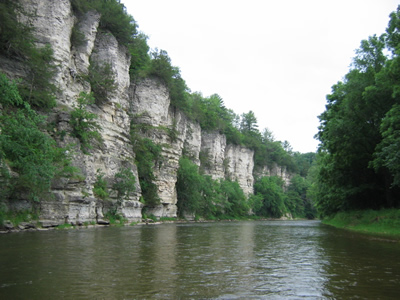[Home][About the UIRW][Fund Raising] [Water Sampling] [Maps][Photo Tour] [Publications] [Links] [Partners]

|
•Recent
Developments• |
Upper
Iowa River Watershed Project |
Watershed Projects in the
UIRW |
Coldwater Pine Water Quality Project |
|
Located
in extreme Northeast Iowa and Southeast Minnesota, the Upper Iowa River
(UIR) and its watershed are valuable natural and economic resources.
The Upper Iowa River watershed (UIRW) is a 1,005 square mile watershed
recognized by the EPA and the State of Iowa in the Unified Watershed
Assessment as a Priority Watershed.
The UIR watershed
is an area of rugged hills and steep topography with diverse land
use. The surface water system in this watershed is made up of a complex
network of spring fed coldwater trout streams. It contains 29 stream
segments designated as Class B Cold Water Aquatic Life and the Iowa
DNR, Fisheries Division, is in the process of reclassifying several
new segments in the watershed to this designation. The Northeast Iowa
River Basin Study (NIRBS) of Iowa and Minnesota, conducted by the
U.S. Department of Agriculture in 1986, identified 25 Highest Priority
Coldwater Streams. More of these priority streams (9 of 25) are in
the UIR watershed than in any other system included in the study.
The land area that drains into these 9 priority streams covers more
than half of the area included in the total. There are 14 streams
in the UIR watershed that are stocked by the Iowa DNR with The Upper Iowa River and its tributaries contribute to the economic health of the region. The waters of Northeast Iowa are a major attraction for anglers and other water recreationists. The Upper Iowa Watershed is noted for its fine fisheries, and the Iowa DNR estimates over 314,000 angler trips per year are made to the Upper Iowa River Watershed stimulating over $29 million dollars of economic activity each year. The Iowa DNR estimates canoeists enjoying the Upper Iowa River generate another $5 million yearly. Local DNR Fisheries Biologists consider these estimates, which are based on the area of the watershed, to be extremely low. |
|
The publication of this document has been funded in part by Northeast Iowa RC&D, Inc. and by the Iowa Department of Natural Resources through a grant from the U.S. Environmental Protection Agency under the Federal Nonpoint Source Management Program (Section 319 of the Clean Water Act). The
United States Department of Agriculture prohibits discrimination in
its programs on the basis of race, color, national origin, gender, religion,
age, disability, political beliefs, sexual orientation, and marital
or family status. (Not all prohibited bases apply to all programs.)
Persons with disabilities who require alternative means for communication
of program information (Braille, large print, audiotape, etc) should
contact USDA’s TARGET Center at 202-720-2600 (voice and TDD).
To file a complaint of discrimination, write USDA, Director, Office
of Civil Rights, Room 326W, Whitten Building, 14th and Independence
Avenue, SW, Washington, DC 20250-9410 or call (202) 720-5964 (voice
or TDD). USDA is an equal opportunity provider and employer. |
 Although
it was ultimately withdrawn, the UIR was designated by the 90th U.S.
Congress as among the initial 27 rivers to be included in the National
Wild and Scenic River System. A portion of the river and several tributaries
are designated as High Quality Resource Waters as explained in the
Code of Iowa as “waters of exceptional recreational or ecological
significance”. There are 64.2 miles of the UIR and 314 total
river/stream miles in the UIR watershed that have been designated
by Iowa as State Protected Waters Areas (PWA). The Upper Iowa River
has 113 miles designated by the State of Iowa as Class A, Primary
body contact.
Although
it was ultimately withdrawn, the UIR was designated by the 90th U.S.
Congress as among the initial 27 rivers to be included in the National
Wild and Scenic River System. A portion of the river and several tributaries
are designated as High Quality Resource Waters as explained in the
Code of Iowa as “waters of exceptional recreational or ecological
significance”. There are 64.2 miles of the UIR and 314 total
river/stream miles in the UIR watershed that have been designated
by Iowa as State Protected Waters Areas (PWA). The Upper Iowa River
has 113 miles designated by the State of Iowa as Class A, Primary
body contact.  catchable size rainbow, brown, and brook trout. There are 9 additional
streams stocked with fingerling trout that grow to catchable size
in the wild. The last known native population of brook trout in Iowa
is found in the watershed and 11 of the streams in the watershed have
shown natural reproduction of trout.
catchable size rainbow, brown, and brook trout. There are 9 additional
streams stocked with fingerling trout that grow to catchable size
in the wild. The last known native population of brook trout in Iowa
is found in the watershed and 11 of the streams in the watershed have
shown natural reproduction of trout.